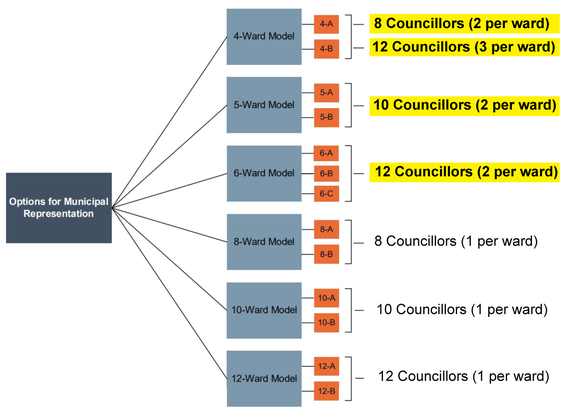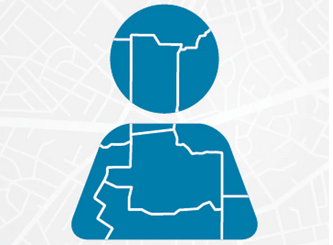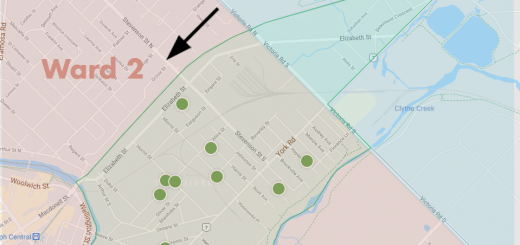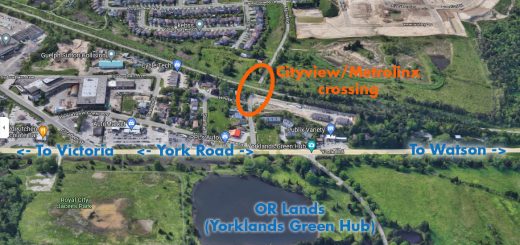Some thoughts on the Council Composition and Ward Boundary Review
NOTE: The consultants have narrowed the scenarios down to 4. a new deadline for input into these scenarios is April 20, 2021. Further discussion of these scenarios can be found here: A new round of consultation on the Council Composition and Ward Boundary Review
The City is asking for public input on proposed changes to ward composition and boundaries. We hope that you will share your preferences with the city at: Have Your Say: Council composition and ward boundary review
Deadline for your submission for this phase of public consultation: Sunday March 14.
There are a lot of options and information to go through. We thought the following could help you with your submission.
Guelph currently has six wards with two councilors per ward. Because of population changes in the current wards the boundaries must be redrawn to balance the population of each ward more equally.
Of the 13 scenarios presented by the consultants, very few satisfy all of the important considerations listed below the scenarios> However these 4 of the 13 proposed scenarios meet many of the considerations:
Scenarios
4-A has 4 wards with 3 councillors per ward = 12 councillors (the number we currently have), or 2 councillors per ward = 10 councillors (2 less than what we currently have) so is potentially proportional. It has Downtown with St. Patrick’s, and the NE of Guelph. It is called Ward 1
4-B has 4 wards with 3 councillors per ward = 12 councillors (the number we currently have) or with 2 councillors per ward = 10 councillors (2 less than what we currently have) so is potentially proportional. It has most of Downtown with St. Patrick’s, and the NE of Guelph. It is called Ward 1.
5-B has 5 wards and 2 councilors per ward = 10 councillors (2 less than what we currently have) so is potentially proportional. It has Downtown with St. Patrick’s, and St. Georges Park neighbourhood and those north together. It is called Ward 1.
6-B has 6 wards and 2 councillors per ward = 12 councillors (the number we currently have) so is potentially proportional. It has Downtown with St. Patrick’s, and St.Georges neighbourhood and those north together. It is called Ward 2. (Note if you like this one, you can ask for it to be called Ward 1)
There are several things that you will probably want to consider when choosing a reconfigured ward system.
1) One is proportionality. A proportional voting system is one where the will of the voters is reflected in the makeup of Council. Vote splitting is reduced with this system. One way of making a voting system more proportional is by having multiple councillors per ward and electing them with a ranked ballot.
The current provincial government has removed the power of implementing ranked ballots from municipalities, but that policy could change, or the government could be replaced by a new one that favors ranked ballots. The best way to prepare for a future proportional system is to retain multiple member wards in Guelph. If we don’t preserve multiple member wards now it will be difficult to go back if provincial government policy changes. Of the 13 options presented, 7 include either 2 or 3 councilors per ward = would allow for your vote to count with proportionality.
2) A second consideration is to keep established communities, such as Saint Patrick’s Ward in the same electoral ward. One proposal (8-A) splits the Ward into two. Several others place the part of the Ward east of Victoria in a different electoral ward.
3) A third consideration is the keep the old Saint Patrick’s Ward in the same electoral ward as downtown. This is important because part of the Ward is within the Downtown Secondary Plan, so shares some planning rules with downtown. A new municipal layout that places The Ward in the same ward as downtown (as it is now), could make planning and development issues in this area easier.
4) A fourth consideration is to keep neighborhoods with similar characteristics together. The ward shares some of the demographics of downtown, the Saint Georges Park neighborhood and the area north of downtown. We are likely to share similar views on planning and development with these areas rather than more suburban parts of town that have their own planning issues.
5) A fifth consideration is the numbering of wards. The consultants have arbitrarily renumbered the proposed new wards. The Ward has been in ward one for many years. There is no reason why any of the above scenarios could be chosen, but renumbered so that the new ward that we find ourselves is numbered one. This seems minor but many people are used to following ward one news and calling the ward one councilor. There are places in the survey to make individual comments on these and other considerations.
Below is a summary of the ward boundary proposals and the perspective number of councillors:





1 Response
[…] a lot of options and information to go through. In an earlier post we outlined in a previous post: Some thoughts on the Council Composition and Ward Boundary Review. 4 of the 13 proposed scenarios met many of the considerations. Of these 4 selected by the […]